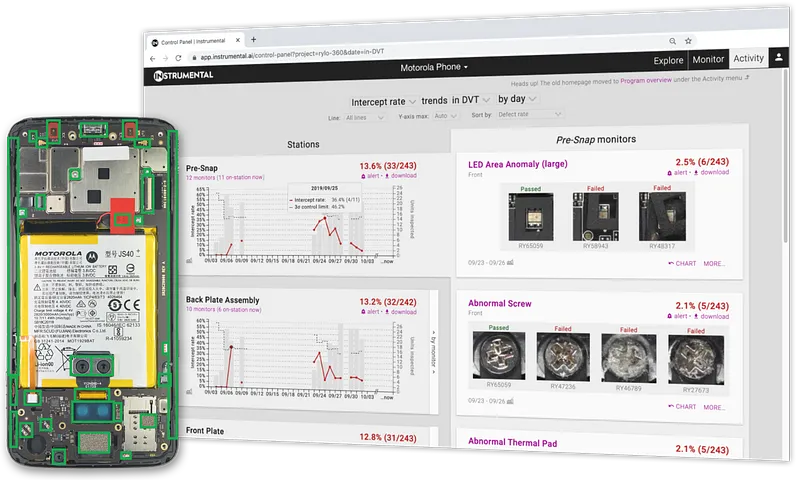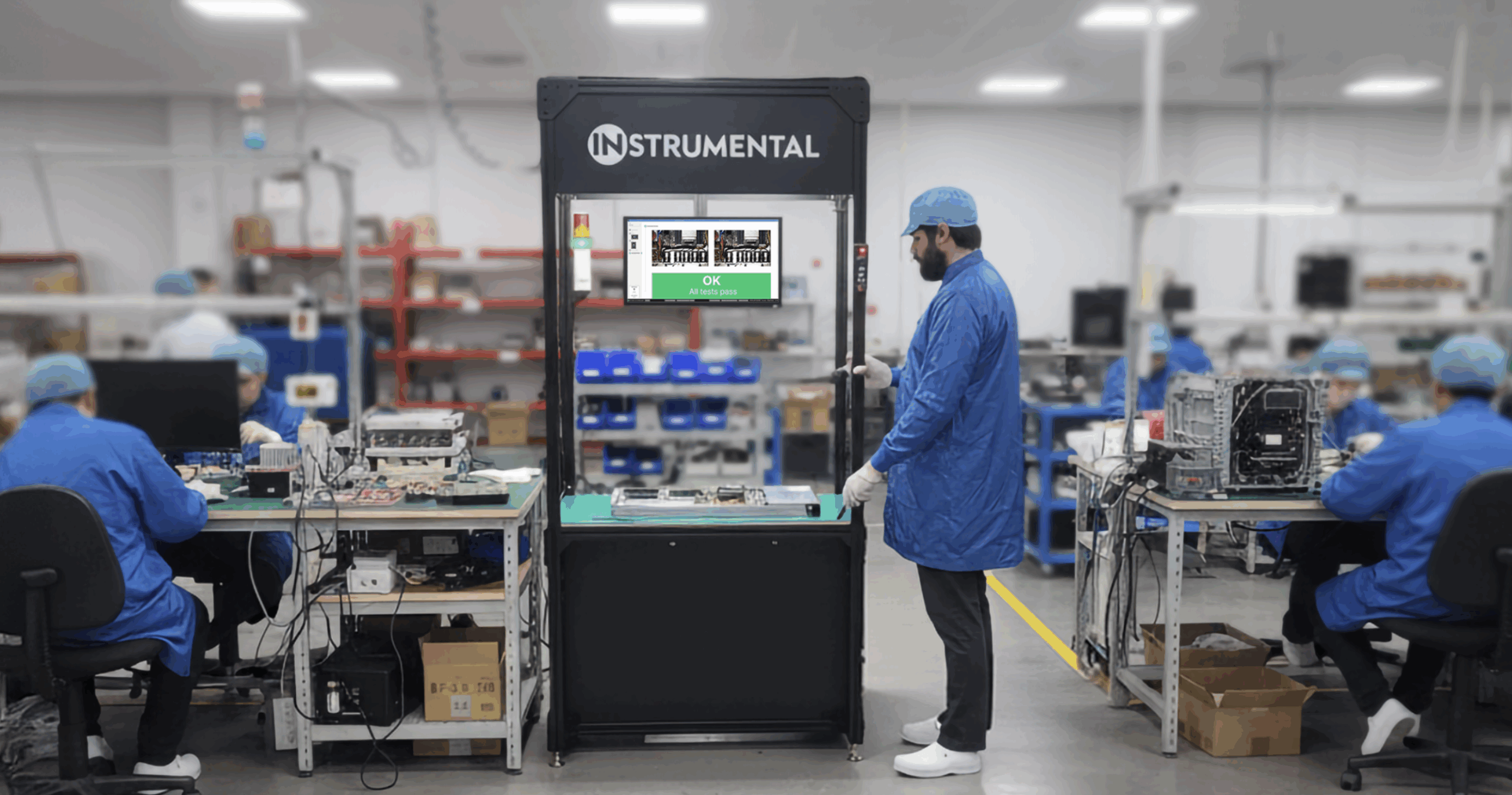$0.25 of every dollar spent in discrete manufacturing is economic waste. Instrumental’s manufacturing optimization platform is bringing unprecedented data visibility and machine learning to help product engineers accelerate product maturity, reduce rework, and improve yields.
Samuel and I founded Instrumental to solve the most frustrating and costly problem we encountered as product design engineers: we never had the right data, at the right level of detail, at the right time. We worked on some of the most advanced electronics in the world at Apple, but our methods for finding issues, conducting failure analysis, and verifying fixes relied on pen-and-paper and boots on the ground. The amount of economic waste in the industry as a whole – time, scrap material, mistakes – was huge.
We soon realized that this wasn’t only frustrating for us on the front lines – it was a massive economic problem for some of the largest companies in the world.
Today, I’m excited to announce our $20M Series B, led by Canaan, to continue to realize our mission of enabling hardware teams to build better products through better data. Eclipse, Root Ventures, Stanford StartX, and First Round Capital also participated in the round.
The problem
Manufacturing is half of the Gross World Product ($48 trillion) but $8 trillion of that is economic waste — mistakes or experiments, wasted time, scrap or rework or product returns. The total scale is staggering, but individual instances can be almost invisible — a misplaced component, an abnormal thermal pad, or soldering errors. And the cost of dark yield (defective units that make it past functional tests and into customer hands) is extreme.
These issues are mostly discovered and resolved during new product introduction (NPI) – the phase of electronics development between initial concept development and mass production when a design is being optimized for manufacture at scale. NPI represents over 50% of a typical program duration, because identifying and solving issues relies on the slow, human processes of identifying issues in the first place, collecting enough data to identify root cause and complete failure analysis, and then designing and validating a fix. The primary tools for this process are pen and paper and putting engineers on planes to take units apart in search of issues.
COVID-19 has unveiled exactly how brittle this process is – brands are already seeing launch delays, high yield fallout, and heightened returns because they can’t fix problems on the line the old way.
Even before COVID, core trends in electronics are putting pressure on this process:
- Everyone’s a critic, and now they have a platform. The days of sending perfect units to tech reviewers are over. Now, a few bad units in early shipments can drag down online reviews. Losing one star on Amazon can reduce sales by 50%, and a cluster of issues can rapidly degrade brand loyalty.
- Software giants are looking to hardware to increase market share, challenging incumbents in an increasing breadth of hardware categories, from phones to medical devices.
- Competition is driving companies to push new products through development faster. Products are becoming more complex, but NPI timelines are getting shorter, not longer, as companies look to get to market before their competitors. People admire Apple’s design, but their success in hardware is all about execution: time-to-market is now a major competitive advantage.
The massive waste happens because it’s too hard to solve problems in manufacturing. In NPI, it’s not possible to reliably discover all of the issues that exist and it’s often too hard to solve them quickly. In the ramp and production phase, it’s too difficult to even measure a lot of the process improvement that is necessary, not to mention actually identify the opportunities and implement the improvements.
Electronics manufacturing is most susceptible because of its fast release cycles: new cell phones, laptops, and other gadgets are ramped from zero to hundreds of thousands or millions each day and back down to zero every year.
Instrumental’s approach to proactive optimization
We’re changing the way design, quality, and workmanship issues are discovered and solved in electronics manufacturing by tackling the three key challenges: aggregation, access, and automation.
While there’s a lot of manufacturing data collected today, it’s generally not the right kind of data, and too low-resolution to be actionable. Aggregation of the right data at problem-solving resolution is difficult. MES generally lack the parametric data from performance test stations necessary for clues into root cause. Automated Optical Inspection (AOI) equipment only saves small crops of the unit’s failing locations – discarding additional context and comparative passing units that would be helpful in failure analysis.
Both can only find issues you are already looking for, which means they don’t actually support issue discovery. When you do discover new issues, you rarely have the complete data record on hand to do failure analysis, which means your only tool is ripping apart units or adding unplanned units to your build.
Instrumental recognizes data collection and aggregation is a key barrier for many companies looking to get more from their product data – so we provide a drop-in, no-integration-necessary station that starts collecting data immediately. Our customers sprinkle these at key stages of assembly, so they can build a complete visual record of every single unit, in a format that can be easily combined with other critical data like measurements and functional test results. This creates a complete source of truth for product data.

Real time access to data is generally absent today. Outsiders may be surprised to hear that most electronics brands still use pencil tick marks to keep track of how many units were built in a shift. If that’s the status quo, forget about real time dashboards or notifications.
Data comes from different systems, only a few people have access, and the different pieces of the tech stack – MES, shop floor systems, functional test stations – are generally completely siloed with bare-minimum integrations. Brands and their engineers generally have no access at all.
We’ve solved this by creating the first intuitive, cloud-based system for remote issue discovery, investigation and communication, making all of your product data accessible in real time.

Finally, there is a deep lack of true automation in discovering issues, performing basic correlations, and validating solutions. Most problem solving in manufacturing today is reactive: engineers analyze partial data sets once issues have already been identified, such as failing a reliability test or due to a customer complaint. Engineers need a way to proactively discover new issues and quickly get to root cause, at the speed of computers, not humans.
This is where the power of Instrumental really lies. Our proprietary AI is purpose-built to proactively identify and quantify previously unknown issues, and empower engineers to quickly identify potential correlations and to track down the root cause. Once trained, it can automatically intercept units with issues directly on the line before they cause more expensive problems downstream. Instrumental’s AI starts providing valuable detections with only 30 units, enabling it to start finding and monitoring issues almost immediately, even in smaller NPI builds. When combined with the rest of Instrumental’s optimization platform, it’s easy to understand risk and failure rate trends, and to set up automated quality alerts for ongoing monitoring.
Where the process of issue discovery, analysis, and solution validation used to unfold over weeks or months, Instrumental enables engineers to identify and solve problems in minutes, hours, or days. By using AI to automate some of the less valuable tasks engineers spend their time on, they are freed up to focus on implementing solutions and building better products.

How it works
The Instrumental Manufacturing Optimization Platform is simple to set up and to use. Instrumental uses cameras, yours or ours, to capture images of each and every product at key stages of the manufacturing process. Each inspection point takes less than an hour to set up, calibrate, and initialize with a first set of units. Once in the cloud, engineers can log in to review the images, identify key locations of the product to look for anomalies, and Instrumental AI will begin to identify defects automatically. As additional data is collected, engineers will be able to review defect rates over time and set up proactive quality alerts to identify shifts as they happen.
As the AI identifies new defect modes, engineers can work within the application to diagnose issues and communicate findings with their factory, supplier, or teammates. Program leaders get real-time dashboards to monitor the overall pareto and defect rate for each issue as it is resolved.
Typical customers discover dozens of previously unknown issues during development, and save hundreds of thousands of dollars in tooling, experiments, and travel. In production, these savings get amplified over high volume, often saving $0.25-$1.25 per unit built.
Electronics leaders like Motorola Mobility, Axon, P2i, and Meraki are already partnering with Instrumental.
About our team
Instrumental’s team is passionate about inventing and providing foundational technology that enables engineers at electronics companies to build better. The research and development team is a unique combination of hardware engineers who have personally lived the pain of optimization problems, and technologists skilled in developing unique new algorithms and building highly reliable and scalable software. Our business team has over three decades of direct experience with the challenges of managing supply chains, scrambling to resolve last-minute issues, and successfully bringing hardware products to market.
What’s next
We’re not stopping at automating the most time-consuming, but least creative, parts of product engineering. We’re meeting the need for an easier, more reliable, more complete way to optimize designs and manufacturing processes to bring complex products to market faster and enable continuous improvements in yield and reliability.
COVID-19 has shown the cracks in the old way of spreadsheets, emails, blurry cell phone photos, and intercontinental travel. It has highlighted how problematic siloed systems are, accelerated progress toward cloud-based solutions for engineers, and catalyzed a new wave of thinking around how optimization can have an outsized impact on core manufacturing metrics.
Real-time visibility, analysis, and monitoring is the key to successfully surviving the shifting market. Instrumental is providing this critical piece of the manufacturing tech stack. Our technology already enables engineers to make order-of-magnitude efficiency improvements, and we believe that furthering the development of continuous optimization technologies will be the next big step forward for one of the largest industries on Earth. I look forward to the days when my experiences building products at Apple will seem as quaint as the stories of Ford’s Model T assembly lines.
Related Topics



